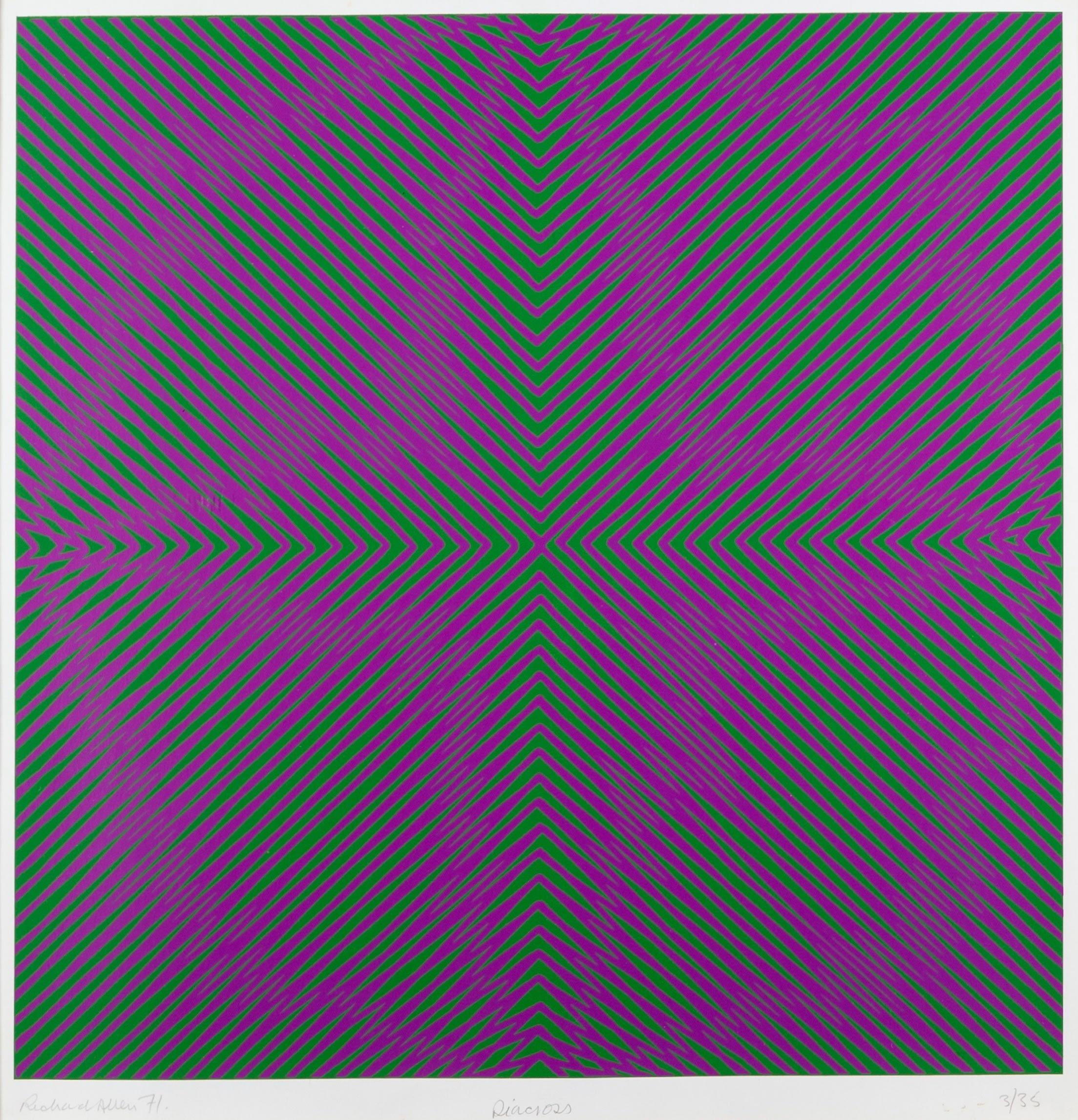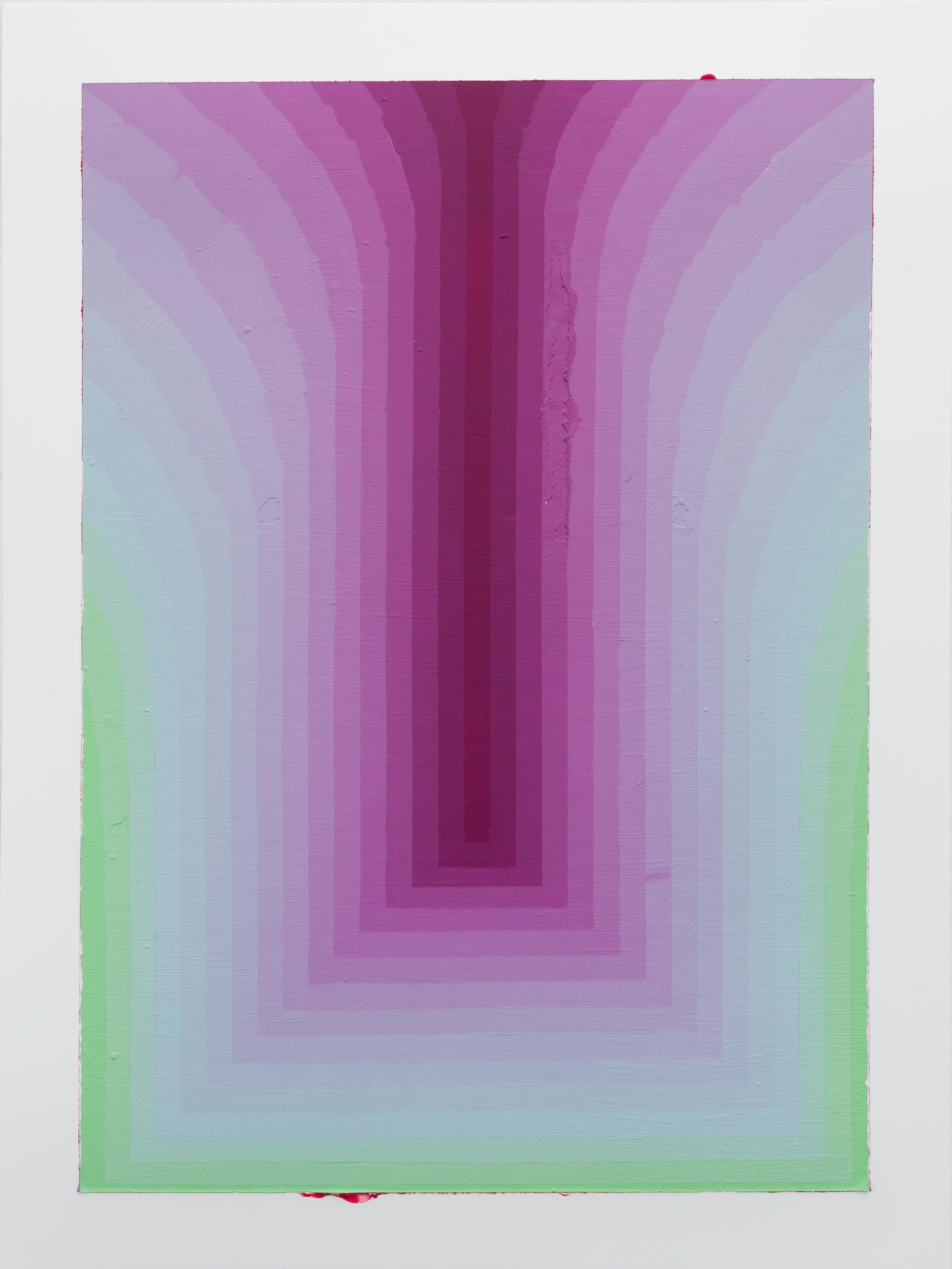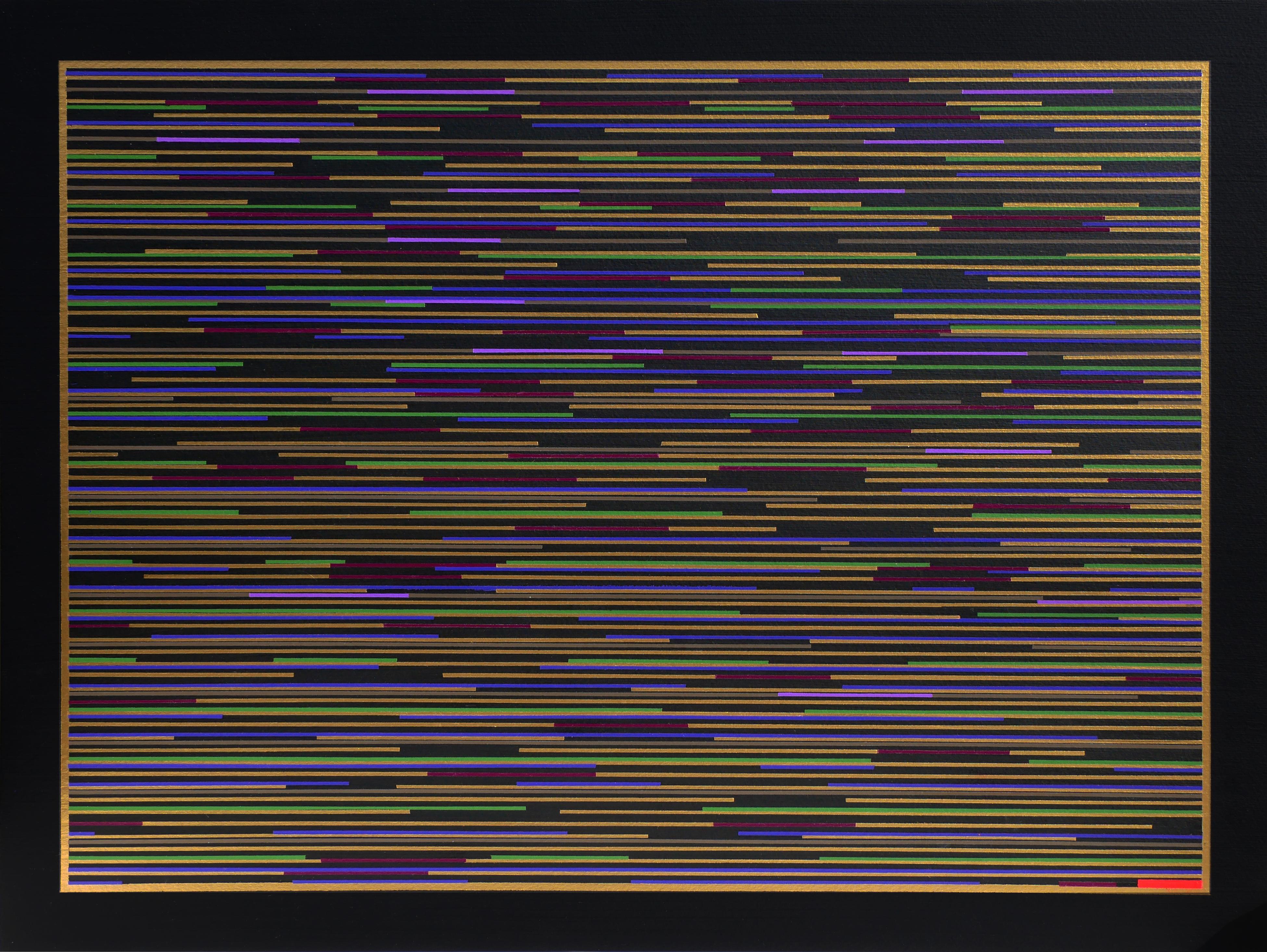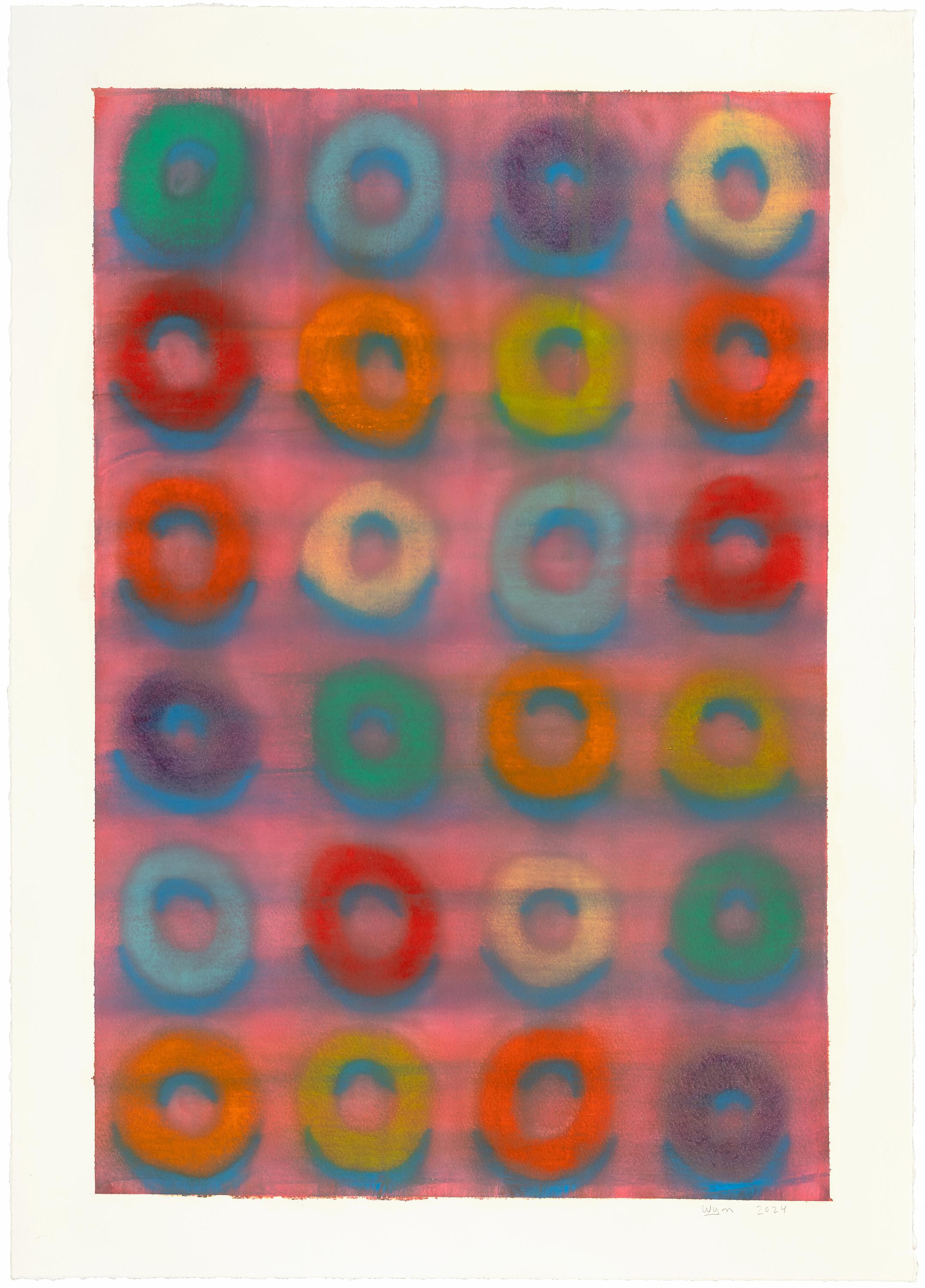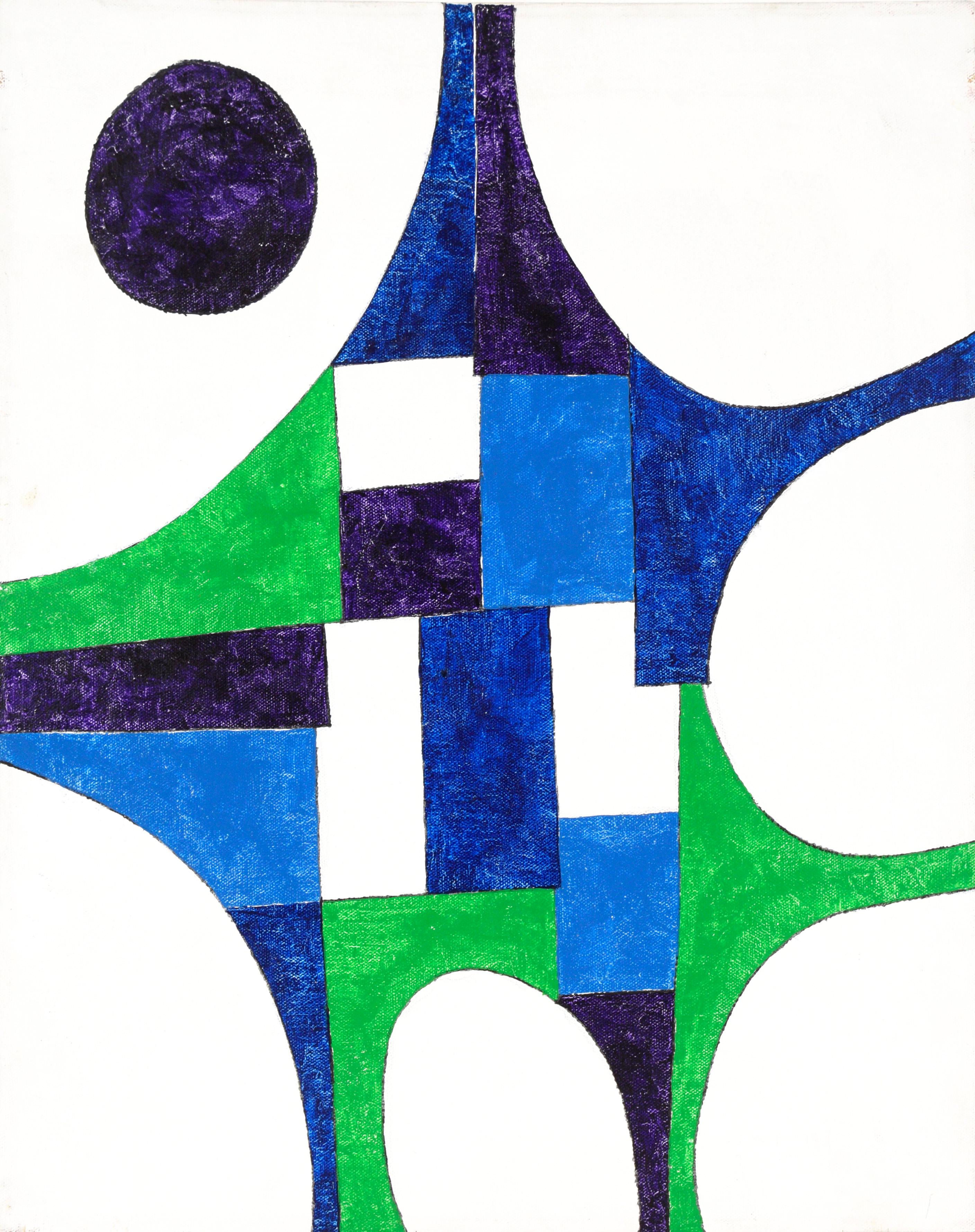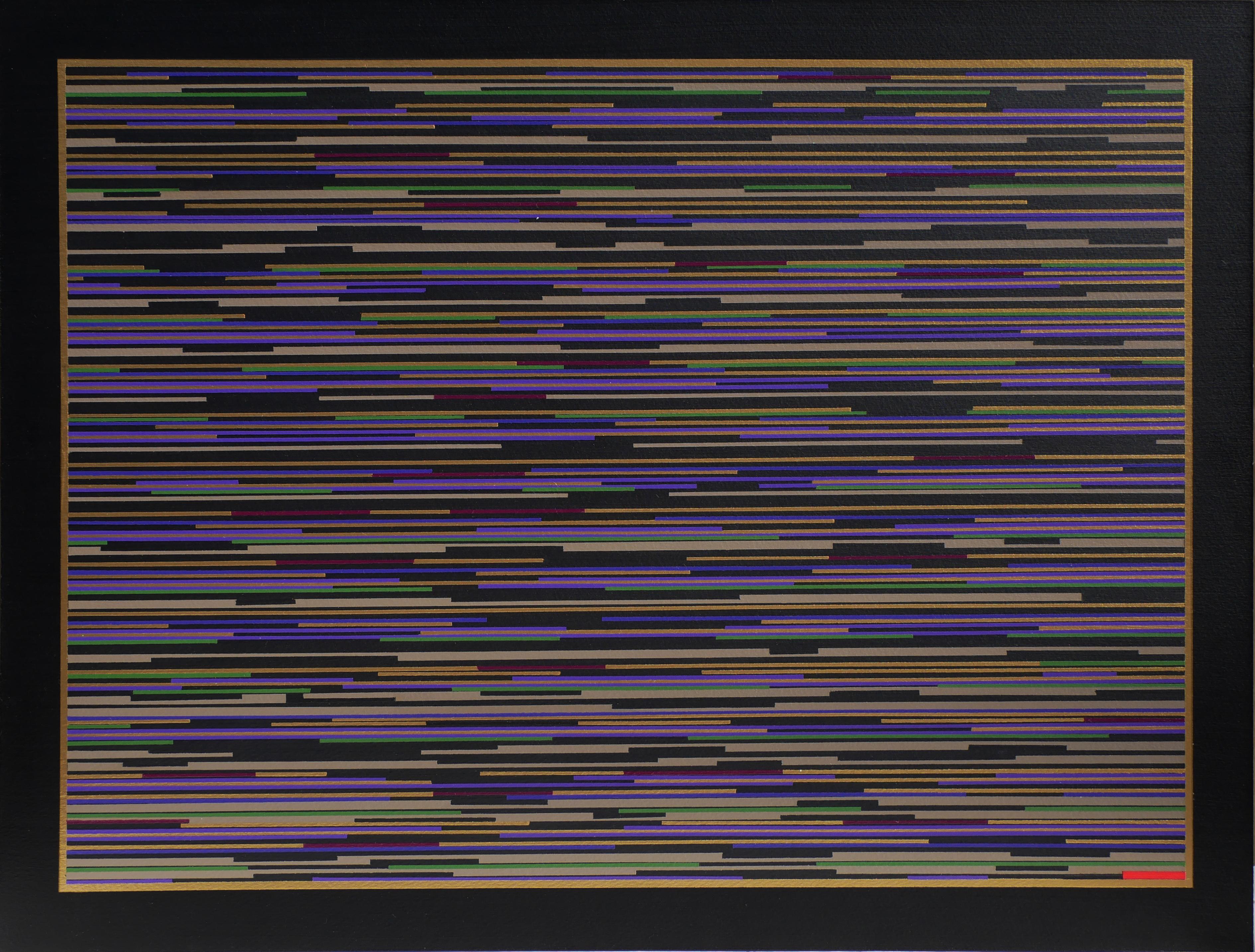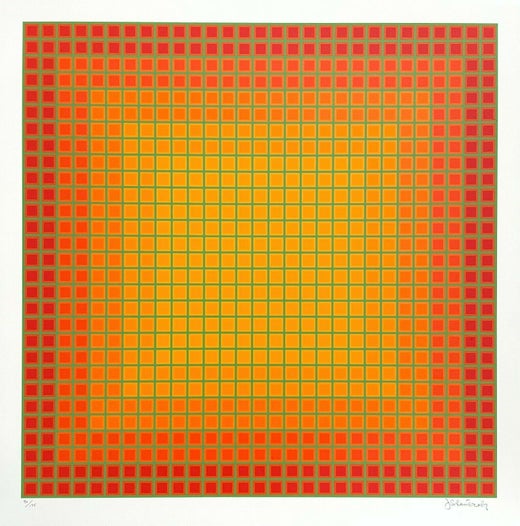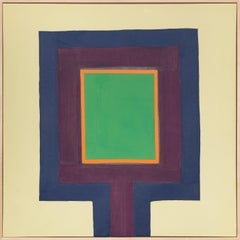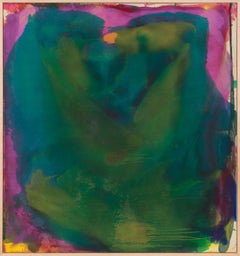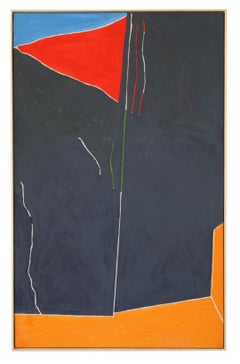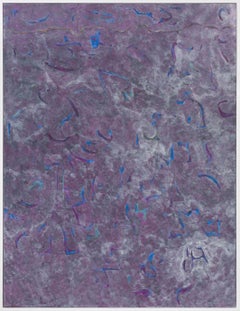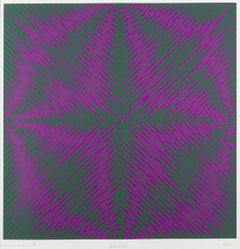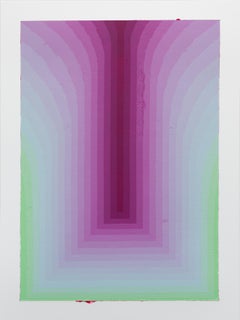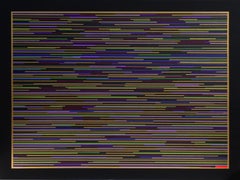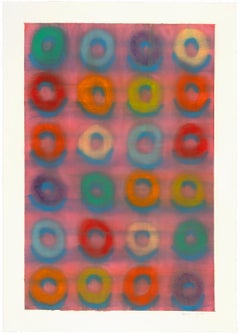Items Similar to Untitled (Green and Purple Circle)
Want more images or videos?
Request additional images or videos from the seller
1 of 9
Julian StanczakUntitled (Green and Purple Circle)1965
1965
$60,000
£45,571.48
€52,415.54
CA$83,831.76
A$93,481.90
CHF 48,774.87
MX$1,147,058.14
NOK 620,826.39
SEK 588,219.52
DKK 391,196.52
Shipping
Retrieving quote...The 1stDibs Promise:
Authenticity Guarantee,
Money-Back Guarantee,
24-Hour Cancellation
About the Item
Acrylic on canvas. Signed verso.
36.5 x 36 in.
42.75 x 42.25 in. (framed)
Custom framed in a solid maple tray frame with an heirloom white finish.
Provenance
Private Collection, Chagrin Falls, OH
Exhibited
"Julian Stanczak" 1973, The New Gallery (now MoCa Cleveland), Cleveland, OH
Born in Borownica, Poland in 1928, Julian Stanczak's childhood was marred by political upheaval in eastern Europe. In 1939, his family was deported to a Siberian gulag, where they spent two years before being granted amnesty. Due to the conditions in the camp, the young Stanczak lost the use of his dominant right arm, which made his subsequent artistic achievements that much more impressive.
Following their internment in Siberia, the family migrated south - first through central Asia, then the Middle East, on to north Africa, before finally settling in a Polish refugee camp in Uganda in 1942. The family would remain in Uganda for six years, during which time Stanczak received his first private art lessons. In 1948, the family briefly moved to London, where they lived for two years before ultimately deciding to immigrate to the United States.
In 1950, Stanczak arrived in Cleveland, OH, and at some point thereafter, enrolled at the Cleveland Institute of Art. He graduated with a BFA in 1954 and was subsequently admitted to the MFA program at Yale, which he completed in 1956. During his time at Yale, Stanczak studied under Josef Albers and Conrad Marca-Relli, and was roommates with Richard Anuszkiewicz. After receiving his MFA, Stanczak became a U.S. citizen and began a seven-year tenure teaching at the Art Academy of Cincinnati.
The 1960s proved transformative for Stanczak, beginning in 1963, when he married the artist Barbara Meerpohl. The following year, he won first prize in an exhibition sponsored by the Dayton Museum of Art entitled Artists of Southern Ohio. This caught the eye of the famed gallerist Martha Jackson, who immediately added Stanczak to the prestigious roster of artists at her eponymous gallery in New York. Later that year, Jackson gave Stanczak his first solo show at the gallery, Julian Stanczak: Optical Paintings. In a review for Arts Magazine, the artist Donald Judd coined the term "Op Art" when describing Stanczak's use of shapes and color.
In 1965, Stanczak's work was included in The Responsive Eye - a landmark exhibition at the Museum of Modern Art (MoMA) in New York, curated by William Seitz. This exhibition paved the way for the emergence of Op Art as a distinct movement in its own right, and brought immense recognition and commercial success for the participating artists, including Stanczak.
The 1960s and and 70s proved to be the critical high-water mark of Stanczak's career, as he enjoyed more than 30 solo exhibitions and participated in even more group shows during this period. He also continued to teach, returning to his adopted hometown of Cleveland in 1964, where he would serve as a professor of painting at the Cleveland Institute of Art until his retirement in 1995.
As the popularity of Op Art began to fade toward the end of the 1970s, Stanczak continued to expand his painterly practice, further exploring color theory and experimenting with scale and new media through ambitious public commissions.
With a legacy as one of the central figures of a major 20th-century art movement, Stanczak's work can be found in many public and private collections around the world, including the Metropolitan Museum of Art, New York; MoMA, New York; the Cleveland Institute of Art; the Art Institute of Chicago; the Albright-Knox Art Gallery, Buffalo, NY; the Brooklyn Museum; the Crystal Bridges Museum of American Art, Bentonville, AR; the Dallas Museum of Art; the Los Angeles County Museum of Art; the Hirshhorn Museum and Sculpture Garden, Washington; SFMoMA, San Francisco; the Museum of Fine Arts, Houston; the National Gallery of Art, Washington, and many more.
Julian Stanczak died at his home in the Cleveland suburb of Seven Hills, OH in 2017.
Source: The Stanczak Foundation
- Creator:Julian Stanczak (1928, American)
- Creation Year:1965
- Dimensions:Height: 42.75 in (108.59 cm)Width: 42.25 in (107.32 cm)
- Medium:
- Movement & Style:
- Period:
- Condition:Overall very good and stable condition. Inquire for additional details.
- Gallery Location:Austin, TX
- Reference Number:1stDibs: LU2287215230322
Julian Stanczak
Julian Stanczak was born in Borownica, Poland in 1928. At the beginning of World War II, Stanczak was forced into a Siberian labor camp, where he permanently lost the use of his right arm. He had been right-handed. In 1942, aged thirteen, Stanczak escaped from Siberia to join the Anders' Army in Persia. After deserting from the army, he spent his teenage years in a hut in a Polish refugee camp in Uganda. In Africa, Stanczak learned to write and paint left-handed. He then spent some years in London, before moving to the United States in 1950. He settled in Cleveland, Ohio. He became a United States citizen in 1957, taught at the Cincinnati Academy of Art for 7 years. The Op Art movement was named after his first major show, Julian Stanczak: Optical Paintings, held at the Martha Jackson Gallery in New York in 1964. His work was included in the Museum of Modern Art's 1965 exhibition The Responsive Eye. In 1966 he was named a "New Talent" by Art in America magazine. In the early 1960s he began to make the surface plane of the painting vibrate through his use of wavy lines and contrasting colors in works such as Provocative Current (1965). These paintings gave way to more complex compositions constructed with geometric rigidity yet softened with varying degrees of color transparency such as Netted Green (1972). In addition to being an artist, Stanczak was also a teacher, having worked at the Art Academy of Cincinnati from 1957–64 and as Professor of Painting, at the Cleveland Institute of Art, 1964-1995. He was named "Outstanding American Educator" by the Educators of America in 1970. (Wikipedia)
About the Seller
5.0
Vetted Professional Seller
Every seller passes strict standards for authenticity and reliability
Established in 2020
1stDibs seller since 2023
6 sales on 1stDibs
- ShippingRetrieving quote...Shipping from: Austin, TX
- Return Policy
Authenticity Guarantee
In the unlikely event there’s an issue with an item’s authenticity, contact us within 1 year for a full refund. DetailsMoney-Back Guarantee
If your item is not as described, is damaged in transit, or does not arrive, contact us within 7 days for a full refund. Details24-Hour Cancellation
You have a 24-hour grace period in which to reconsider your purchase, with no questions asked.Vetted Professional Sellers
Our world-class sellers must adhere to strict standards for service and quality, maintaining the integrity of our listings.Price-Match Guarantee
If you find that a seller listed the same item for a lower price elsewhere, we’ll match it.Trusted Global Delivery
Our best-in-class carrier network provides specialized shipping options worldwide, including custom delivery.More From This Seller
View AllGreen Center
By Kenneth Lochhead
Located in Austin, TX
Waterline Fine Art, Austin, TX is pleased to present the following work:
Acrylic on canvas. Signed, dated, and titled verso.
62.25 x 62.25 in.
63.75 x 63.5 in. (framed)
Custom framed in a maple floater with a polyurethane clear coat finish.
Provenance
MacKenzie Art Gallery, Regina, Canada
Private Collection, Lancaster, PA
Exhibited
"," June 2, 2003-July 15, 2004, The Edmonton Art Gallery, Edmonton, Canada.
Publications
"Kenneth Lochhead: Garden of Light...
Category
1960s Post-War Abstract Paintings
Materials
Canvas, Acrylic
Untitled
Located in Austin, TX
Waterline Fine Art, Austin, TX is pleased to present the following work:
Oil on canvas.
63 x 59 in.
64.5 x 60.5 in. (framed)
Custom framed in a s...
Category
Early 2000s Abstract Abstract Paintings
Materials
Canvas, Oil
New Synthesis #34
By Jack Roth
Located in Austin, TX
Waterline Fine Art, Austin, TX is pleased to present the following work:
Acrylic on canvas. Signed, dated, titled, and estate stamped on verso.
50.25 x 31 in.
51.25 x 32 in. (framed)
Custom framed in maple.
Provenance
Estate of Jack Roth
Born in Brockway, Pennsylvania, Jack Roth was at various times a painter, poet, photographer, and mathematician. He enrolled at Pennsylvania State University in 1943 to study chemistry, but like many of his fellow Abstract Expressionists, his matriculation was interrupted World War II, where he served in both the Army and Air Force.
Discharged from the service in 1948, Roth moved to Big Sur, California and married his first wife, Colleen Bleier, with whom he had two daughters. A year later, the young family settled in San Francisco, where Jack enrolled at the California School of Fine Arts. It was here that he studied painting under Mark Rothko, Clyfford Still, Richard Diebenkorn, David Park, and Elmer Bischoff.
The Roth family left the Bay Area to return to Pennsylvania, where Jack completed his Bachelor of Science degree in Chemistry in 1951. In pursuit of his seemingly discordant academic interests, Roth moved yet again, this time to Iowa where he received a Master of Fine Arts at Iowa State University in 1953. Seeking gainful employment, Roth moved to New York, settling in the lower East Side where he began looking for a teaching job and working as a reviewer for Arts Digest magazine.
Now divorced, in 1954 Roth married the artist Rachel Chester whom he had met in Iowa. He continued to paint and work odd jobs, some of which were as a hotel night clerk and an orderly at Beekman Downtown Hospital. That year, he unsuccessfully applied for the Guggenheim Memorial Foundation Fellowship in the field of photography.
However, Roth’s professional prospects greatly improved when his work was selected by James Johnson Sweeney, Director of the Guggenheim Museum of Art for the traveling exhibition Younger American Painters, alongside giants such as William Baziotes, Richard Diebenkorn, Adolph Gottlieb, Philip Guston, Franz Kline, Willem de Kooning, Robert Motherwell, Jackson Pollock, Morris Louis, and others. One of the first major debuts of the Abstract Expressionist movement to be shown at an American museum, the exhibit traveled to the prominent museums across the country. In 1956 he began graduate work in mathematics at New York University.
Opting to dive back into academia, Roth began graduate coursework in mathematics at New York University in 1956. He enrolled at Duke University in 1958, receiving his PhD in mathematics in 1962.
Roth continued to create art throughout the pendency of his graduate studies and in 1963, legendary Museum of Modern Art (MoMA) curators Dorothy Miller and William Lieberman recommended Roth as the new talent graphic artist for Art in America. Concurrently, MoMA purchased several works from Roth for the museum’s permanent collection.
During this period of artistic achievement, Roth continued to teach - first, at the University of South Florida in Tampa, before moving back north to Montclair, New Jersey, where he was hired as the chairman of the Mathematics department at Upsala College. In 1971 he accepted a dual appointment at Ramapo College, teaching both mathematics and advanced painting. After he received tenure and his finances were secure, his artistic production thrived as he received the first Thomases Award for contributions at the school, which came with the use of a large studio space. This allowed him to work with larger canvases and become what he saw as an Abstract Expressionist Color Field painter.
In 1978, the acclaimed gallery Knoedler & Co. in New York began representation of Roth’s work. Other artists represented by the gallery at this time included Alexander Calder, Adolf Gottlieb...
Category
1980s Abstract Geometric Abstract Paintings
Materials
Canvas, Acrylic
Infinity Field (Jerusalem Series III #1)
By Theodoros Stamos
Located in Austin, TX
Waterline Fine Art, Austin, TX is pleased to present the following work:
Acrylic on canvas. Signed lower left; signed, titled, and dated verso.
65.75 x 50.25 in.
67.25 x 51.75 in. (framed)
Custom framed in a maple floater with a matte white finish.
Provenance
Takis Efstathiou, PTE Fine Arts, New York
Private Collection, New York
Theodoros Stamos is heralded as one of the few abstract painters who bridged the New York School’s first and second generations. His age, in particular, afforded him this unique position, as he was the youngest member of the “Irascibles,” the core group of fifteen New York School painters publicized by Nina Leen...
Category
1980s Post-War Abstract Paintings
Materials
Canvas, Acrylic
Untitled (Savant Series)
Located in Austin, TX
Waterline Fine Art, Austin, TX is pleased to present the following work:
Acrylic on canvas. Initialed and dated verso.
48 x 36 in.
49.5 x 37.5 in. (framed)
Custom framed in a maple floater with a polyurethane clear coat finish.
Provenance
Iannetti Lanzone Gallery, San Francisco
Private Collection, San Francisco
Private Collection, Alameda, CA
Charles Strong...
Category
1980s Post-War Abstract Paintings
Materials
Canvas, Acrylic
Infinity Field (Jerusalem Series)
By Theodoros Stamos
Located in Austin, TX
Waterline Fine Art, Austin, TX is pleased to present the following work:
Acrylic on canvas. Signed, titled, dated, and inscribed verso.
68 x 50 in.
69.5 x 51.75 in. (framed)
Custom framed in a maple floater with a matte white finish.
Provenance
Camillos Kouros Gallery, New York
Private Collection, New York
Theodoros Stamos is heralded as one of the few abstract painters who bridged the New York School’s first and second generations. His age, in particular, afforded him this unique position, as he was the youngest member of the “Irascibles,” the core group of fifteen New York School painters publicized by Nina Leen...
Category
1980s Post-War Abstract Paintings
Materials
Canvas, Acrylic
You May Also Like
Diacross (Purple and Green) by Richard Allen, 1971
By Richard Allen
Located in Kingsclere, GB
Diacross (Purple and Green) by Richard Allen, 1971
Additional information:
Medium: screenprint
58 x 56 cm
22 7/8 x 22 1/8 in
signed, dated and numbered 3/35 in pencil
Richard Allen was an Abstract artist of the 20th century who worked across painting, graphic and technological media.
Allen was born in Worcester in 1933. Influenced by his father, he attended Shropshire Institute of Agriculture where he studied for a National Diploma. From there he became aware of what he considered his “irrational” yet unshakeable interest in art, since the College shared buildings with Worcester School of Art. Upon the advice of his window-cleaner Bob, Allen decided to apply to the School. Whilst in Worcester he attended Geoffrey Whiting...
Category
20th Century Abstract Prints
Materials
Screen
Study for As If Eight - Contemporary Abstract Purple Blue Green Stripes, 2024
By Audrey Stone
Located in Kent, CT
In this contemporary painting in acrylic on Yupo paper, gradient stripes of color in purple, pale blue and light green hues are vibrant and carefully ordered. Signed, dated and title...
Category
2010s Contemporary Abstract Paintings
Materials
Paper, Acrylic
"VMP 5" Purple, Green, and Blue Striped Contemporary Abstract Painting
Located in Houston, TX
Contemporary abstract geometric painting by artist Mark Byckowski. The work is featured in a series of paintings on a rag surface watercolor board. The work features horizontal lines...
Category
21st Century and Contemporary Abstract Geometric Abstract Paintings
Materials
Acrylic, Rag Paper
Untitled (24 Froot Loops Green Violet Pink)
Located in Red Bank, NJ
This original oil painting is noted for its bright and vivid color palette and soft, yet distinctive geometric shapes that appear to dance within the frame. The artist, Wynn Gay, wri...
Category
21st Century and Contemporary Abstract Geometric Abstract Paintings
Materials
Oil Crayon, Oil, Archival Paper
Abstract Geometric Composition in Green, Blue, White, and Purple
Located in Soquel, CA
Abstract Geometric Composition in Green, Blue, White, and Purple - Acrylic on Canvas
Bold abstract composition by Robert William Hinds (American, b. 1926). The central shape in this...
Category
1990s Contemporary Abstract Paintings
Materials
Canvas, Acrylic, Stretcher Bars
"VMP 6" Purple and Green Striped Contemporary Abstract Painting
Located in Houston, TX
Contemporary abstract geometric painting by artist Mark Byckowski. The work is featured in a series of paintings on a rag surface watercolor board. The work features horizontal lines...
Category
21st Century and Contemporary Abstract Geometric Abstract Paintings
Materials
Acrylic, Rag Paper
